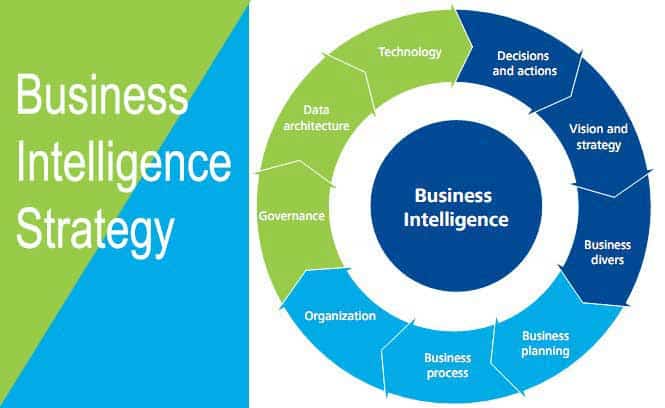Business Intelligence Strategy
Business intelligence (BI) strategy is a roadmap that outlines how an organization will leverage data and analytics to achieve its business objectives. A well-defined BI strategy enables businesses to make informed decisions, improve operational efficiency, and gain a competitive edge in the marketplace. Below are the key components of a successful business intelligence strategy:

1. Define Business Objectives
- Identify Goals: Clearly define the business objectives that the BI strategy aims to support. These goals could include increasing revenue, reducing costs, improving customer satisfaction, or enhancing operational efficiency.
2. Assess Current State
- Data Audit: Conduct a thorough assessment of existing data sources, quality, and infrastructure. Identify gaps and areas for improvement to ensure that the organization has access to reliable and relevant data for decision-making.
- Technology Assessment: Evaluate the current BI tools, systems, and technologies in use. Determine whether they meet the organization’s needs and are capable of supporting the desired BI capabilities.
3. Stakeholder Engagement
- Identify Stakeholders: Identify key stakeholders across the organization who will be involved in or impacted by the BI strategy. This may include executives, department heads, data analysts, and IT personnel.
- Engage Stakeholders: Collaborate with stakeholders to understand their requirements, challenges, and priorities. Ensure that the BI strategy aligns with the needs and objectives of the various stakeholders.
4. Develop Data Governance Framework
- Data Quality Standards: Establish standards and processes for ensuring the accuracy, completeness, and consistency of data.
- Data Security: Define protocols and access controls to protect sensitive data and ensure compliance with regulatory requirements.
- Data Privacy: Implement measures to safeguard customer and employee data and ensure compliance with privacy regulations such as GDPR and CCPA.
5. Identify Key Performance Indicators (KPIs)
- Define KPIs: Identify the key metrics and performance indicators that will be used to measure the success of the BI strategy. These KPIs should be aligned with the organization’s business objectives and provide actionable insights.
- Dashboard Design: Develop dashboards and visualizations to track KPIs and monitor performance in real-time. Ensure that the dashboards are intuitive, customizable, and accessible to relevant stakeholders.
6. Select BI Tools and Technologies
- Evaluate Options: Assess different BI tools and technologies available in the market based on factors such as functionality, scalability, ease of use, and cost.
- Select Tools: Choose the BI tools and technologies that best align with the organization’s requirements and long-term goals. Consider factors such as integration capabilities, vendor support, and future scalability.
7. Implement and Deploy BI Solution
- Data Integration: Integrate data from various sources into the BI platform to create a single source of truth. Ensure that data is cleansed, transformed, and standardized to facilitate analysis.
- User Training: Provide comprehensive training to users on how to use the BI tools and interpret the insights generated. Empower users to self-serve and explore data to drive decision-making.
- Change Management: Implement change management processes to ensure a smooth transition to the new BI solution. Address resistance to change and communicate the benefits of the BI strategy to stakeholders.
8. Monitor and Evaluate Performance
- Continuous Improvement: Regularly review and refine the BI strategy based on feedback, changing business needs, and technological advancements.
- Performance Evaluation: Monitor the performance of the BI solution against established KPIs and objectives. Identify areas for improvement and optimization to maximize the value derived from BI investments.
Conclusion
A well-defined business intelligence strategy is essential for organizations to harness the power of data and analytics to drive business success. By defining clear objectives, engaging stakeholders, establishing robust data governance practices, selecting the right tools and technologies, and continuously monitoring performance, organizations can develop a BI strategy that enables informed decision-making, drives innovation, and fuels growth.